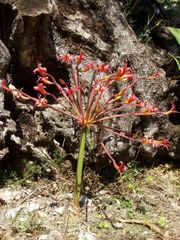Brunsvigia
| Brunsvigia subsp. var. | ||||||||||||||||||||||||||||||||||||||||||||||||||||||||
|---|---|---|---|---|---|---|---|---|---|---|---|---|---|---|---|---|---|---|---|---|---|---|---|---|---|---|---|---|---|---|---|---|---|---|---|---|---|---|---|---|---|---|---|---|---|---|---|---|---|---|---|---|---|---|---|---|

|
|
| ||||||||||||||||||||||||||||||||||||||||||||||||||||||
| ||||||||||||||||||||||||||||||||||||||||||||||||||||||||
Brunsvigia is a flowering plant genus in the family Amaryllidaceae. It contains about 20 species native to South Africa.
Brunsvigia are tender bulbs, winter-growing and summer-dormant, generally flowering in early autumn. Their flowers are brilliant scarlet, pink, or red.
| Standard Cyclopedia of Horticulture |
|---|
|
Brunsvigia (after the Duke of Brunswick). Amaryllidaceae. Tender summer- or autumn-flowering bulbs. Umbels of large numerous brick-red fls.; corolla funnelformed, 6-parted, deciduous, its segms. nearly equal, recurved at the tip.—Species 9. S. Afr. The bulbs must be thoroughly rested from the time the leaves fade until the scape appears. Brunsvigias are hard to flower. They require rich, sandy soil, plenty of heat and sunlight. When growing, give water and liquid manure freely. They propagate by offsets. For fuller instructions, see Amaryllis. B. falcata, Ker-Ammocharis falcata.—B. magnifica, Lind. Fls. 20-25 in a cluster; corolla short; the segm. white, with medium stripe of red or purplish red: Lvs. 1-2 ft. long, 3-3½ in. wide, recumbent.—Thought by Baker to be Crinum Forbesianum or near that species.
|
Cultivation
Propagation
Pests and diseases
Species
Species include:
- Brunsvigia appendiculata
- Brunsvigia bosmaniae
- Brunsvigia comptonii
- Brunsvigia grandiflora
- Brunsvigia gregaria
- Brunsvigia herrei
- Brunsvigia josephinae
- Brunsvigia litoralis
- Brunsvigia marginata
- Brunsvigia natalensis
- Brunsvigia orientalis
- Brunsvigia pulchra
- Brunsvigia radula
- Brunsvigia radulosa
- Brunsvigia striata
- Brunsvigia undulata
Gallery
-
photo 1
-
photo 2
-
photo 3
References
- Standard Cyclopedia of Horticulture, by L. H. Bailey, MacMillan Co., 1963
External links
- w:Brunsvigia. Some of the material on this page may be from Wikipedia, under the Creative Commons license.
- Brunsvigia QR Code (Size 50, 100, 200, 500)
